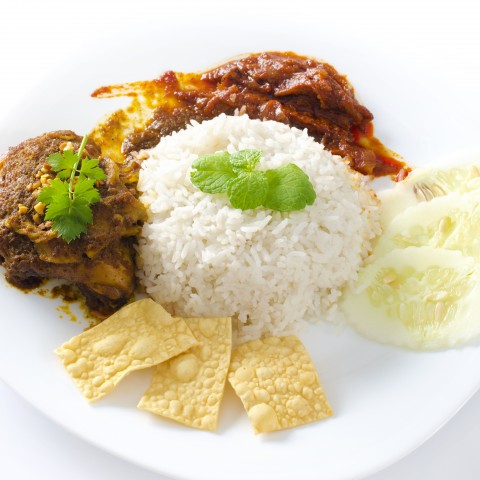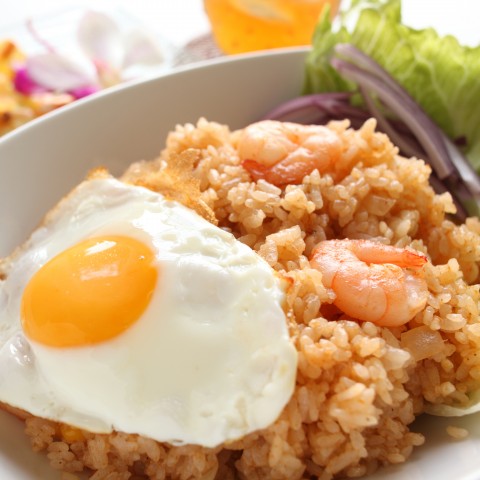
When you travel to a foreign country for the first time, one of the main attractions is the restaurants. Even if you start with something familiar like a fast-food chain, foreign restaurants always have something intangibly different about them.
That makes them excellent places to practice your language skills.
Besides satisfying your cravings, ordering food in a foreign language is the perfect hurdle to clear on your way toward proficiency. It’s authentic language usage, but in a small and controlled environment where you can be forgiven for making mistakes.
In this article, you’ll learn about the many tasty Indonesian foods on offer, as well as some practical restaurant phrases to help you get by.
 Table of Contents
Table of Contents
- What is Indonesian Food Like?
- Must-Try Dishes in Indonesian Restaurants
- Unique Indonesian Food
- Food-Related Vocabulary
- Bonus: Simple Recipes to Make Authentic Indonesian Food at Home
- Conclusion
1. What is Indonesian Food Like?

Unless you’ve looked out for one, you’ve probably never seen an Indonesian restaurant. Although there are tens of thousands of Indonesians living outside Indonesia, they don’t tend to open up restaurants. Whatever the reasons may be for that, it just makes the experience all the better when you actually get to one.
Indonesian food is, of course, quite diverse, as the culture of each province can differ significantly throughout the archipelago. In this article, we’ll focus largely on the food found in the most populous cities of Java, the most populous of the islands.
Generally speaking, Indonesians like spicy food with rice and vegetables, often without any additional sauce and frequently fried.
In the largest cities, you can find a wide range of restaurants catering to any budget size. The smallest places are called warungs, and they tend to be quick counter-serve restaurants with similar menus and few house specialties (if any).
Moving one step up, you’ll find larger rumah makan, or restaurants serving their own specialties made with a bit more creativity than warungs offer. That’s not a mark against the tastiness of food from a warung, mind you!
Finally, the nicest restaurants are in the downtown areas or in the malls. These are often part of chains, and some offer food from around Asia. It’s easy to find excellent Japanese, Korean, Chinese, and Thai food all in the same food court.
But let’s imagine you’re in a highly recommended rumah makan. What can you expect from authentic Indonesian cuisine? What’s on the menu?
2. Must-Try Dishes in Indonesian Restaurants

If your chef comes from Central Java, they’ll probably be including gudeg on the menu. This is the classic dish of the city of Yogyakarta, and it’s made with slow-simmered jackfruit and coconut milk to create a rich and creamy stew. It definitely takes quite some time to cook, but they say it’s part of the Javanese outlook on life.
Another slow-cooked dish is rendang, a dry curry. First you take some tender beef and boil it in a coconut milk curry—and then you keep boiling it until the curry dries into a paste. Then it gets fried, and the outcome is a perfectly tender and spicy rendang.
Next is a spicy salad with peanut sauce known as gado-gado. Peanuts actually aren’t particularly common in Indonesian cooking (they’re much more associated with Thai cooking), and neither are salads. That doesn’t stop gado-gado from being a very filling, very spicy, and very nutritious meal!
Most people know about something called satay, which is pretty widely known in Southeast Asian cooking as a Malaysian dish. It can be spicy or sweet, and you can get it with beef (sate sapi) or goat (sate kambing). Also note that it’s spelled sate in Indonesian.
Finally, nasi goreng literally translates to “fried rice.” This Indonesian rice dish is different from traditional Chinese fried rice because of the spices used and how it usually doesn’t include as many vegetables. You can always tell a plate of nasi goreng from other fried rice because it’s patted into a sort of ball and sprinkled with fried shallots.
3. Unique Indonesian Food

The foods mentioned above are definitely staples of the Indonesian diet, but they can often be found in Singapore or Malaysia as well. As it happens, there are also plenty of beloved foods in Indonesia that can really only be had in-country.
First among these is an unassuming jus alpukat, literally “avocado juice.” Since avocados are naturally creamy, it ends up being more of a milkshake than a juice. The secret to an excellent jus alpukat is to add a bit of sugar, a bit of cream, and to drizzle the inside of the cup with chocolate syrup before adding the blended avocado.
Next up is martabak, a classic late-night food to be had while cruising the streets on your motorbike. Anybody who’s spent time in the Middle East might be familiar with this crepe-like folded pancake, but in Indonesia it takes on a new twist. Typical for Indonesia, this traditionally savory dish is turned into a sweet one. You can often tell a martabak stall from other snack stalls by the cans of condensed milk stacked up to the ceiling!
Indomie is a beloved instant noodle brand that, fortunately, can be found around the world, even where there are no Indonesian restaurants for miles. It’s a staple in small warungs, where the noodles are boiled for moments before being flash-fried into a savory and crunchy dish.
Last on the list is ayam geprek, a twist on fried chicken that’s popular among university students for its convenience. It’s a breaded chicken breast beaten to a pulp with peppers mixed in, easy to eat as finger food and easy to share with friends!
4. Food-Related Vocabulary

Now that you’re all ready to eat, it’s time to learn exactly what to say throughout the course of your restaurant visit.
First off, you should be able to easily ask about whether the food you want is spicy or sweet. To call a waiter over, you’ll use the word permisi, so let’s start there.
- Permisi, apakah ayamnya manis? / “Excuse me, is the chicken sweet?”
Indonesian food is often rather manis, but foreigners don’t usually mind. What they mind a lot more is pedas (“spicy”). Cooks and waiters may try to hit you with a fast and short phrase:
- Mau pedas nggak? / “Do you want it spicy?”
Or they may simply say:
- Berapa cabe? / “How many peppers?”
Indonesian spices are different from the more international Mexican or Chinese spices, so tread carefully!
Indonesia is a country with several different religions and cultures co-existing, especially between the mostly Muslim island of Java and the mostly Hindu island of Bali. Everyone is familiar with some kind of dietary restriction or another, so feel free to ask:
- Apakah ini ada sapi/babi? / “Does this have beef/pork?”
Finally, after you’ve eaten your fill, feel free to compliment the chef.
- Enak sekali, Bu/Pak! / “It was delicious, ma’am/sir!”
5. Bonus: Simple Recipes to Make Authentic Indonesian Food at Home

No plans to travel to Indonesia soon? You can still experience something quite close to real Indonesian cuisine at home with these fast recipes.
- → Don’t forget to see our vocabulary list on Cooking for some useful everyday words!
A- How to Make Indomie Sosis
You can order it online or find it in an Asian grocery store, but just make sure you get the mi goreng (“fried noodles”) flavor of Indomie. As a bonus, the packages all have instructions in Indonesian!
First, cook the noodles. Instant noodles cook fast (that’s the point) but you have to be careful not to let them soak up too much water. When they’re about half-cooked, take them out, let them dry a moment, and immediately put them into some hot oil for frying.
As they’re cooking, add the sauce packet from the Indomie packet so that the noodles get cooked in the oil and the kecap (sweet soy sauce).
Next, put the powdered flavoring at the bottom of an empty bowl and add the noodles on top. Layer on a fried egg (telur) or hot dog (sosis), and now you’ve got the perfect warung snack!
B- How to Make Ayam Geprek
This crispy chicken dish is both unique and extremely simple.
First, create an egg and flour batter for a chicken breast and deep-fry it to your own taste. Add a bit of salt and pepper to the batter for extra flavor, and make it a relatively thick breading, too.
Then put a couple of fresh or pickled chili peppers in a mortar and pestle, place the freshly fried chicken on top of them, and beat it to a pulp. The breading will break apart, and the chili juices will flavor both the breading and the white meat.
Be careful, though. If you’re using actual Indonesian peppers, this can be an extremely potent dish. Many foreigners start with just half a pepper and work their way up.
6. Conclusion
Of course, there’s a lot more to the Indonesian language than just food words.
With IndonesianPod101, you can start from scratch and build up a seriously impressive knowledge of the Indonesian language and culture in just one place.
You can start out with beginner articles and podcast lessons, and follow the track of study all the way up to lengthier texts and authentic conversation videos. It’s all here, and it’s all ready for you to learn with.
Start today and be totally prepared for your next visit to an Indonesian restaurant!
Which Indonesian food are you most excited to try, and why? Let us know in the comments!










